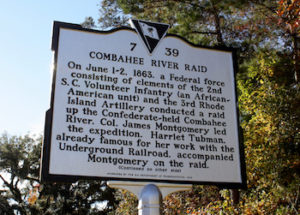
*The Combahee River Raid occurred on this date in 1863; led by Harriet Tubman.
In May of 1862 Tubman traveled to South Carolina where she joined Dr. Henry K. Durand, the Director of the freedman’s hospital at Port Royal. Soldiers as well as fugitives were dying; some of the most common illnesses were typhoid, cholera, malaria, yellow fever, chicken pox and dysentery. Tubman was knowledgeable in local roots to treat diseases; her healing powers became legendary among soldiers.
After the Emancipation Proclamation went into effect on January 1, 1863 black people were allowed to enroll in the military. They were under scrutiny and many doubted about their commitment and bravery. Tubman became part of a group of scouts in charge of espionage and she was the commander of the team. She reported directly to Generals David Hunter and Rufus Saxton. She was assigned to create lifelines and escape routes for trapped slaves. On the night of June 2, 1863 Tubman guided a troop of 150 black soldiers of the Second South Carolina battalion on the Combahee River. The plan was to liberate as many slaves by catching slaveholders by surprise. The attack became known as the Combahee River Raid and liberated more than 750 slaves.
Tubman’s accomplishments in the Combahee River Raid stayed anonymous until July 10, 1863 when a journalist Franklin B. Sanborn published an article “Harriet Tubman”, it was a biographical outline of Tubman’s life. Sanborn’s article was published in the Commonwealth, an antislavery newspaper in Boston. He brought Tubman closer to the white spotlight praising her for guiding slaves to freedom using the Underground Railroad and by risking her life.